
|
|||||||||||||||||||
| Accidentally in Love | |||||||||||||||||||
“I actually wanted to study biology when I started my undergraduate degree,” she said, “but my father is an engineering physicist and made it clear to me that he thought I should study a more quantitative science”. To keep both herself and her father happy she took a double major in physics and physiology at McGill University. She quickly found the math portion of the degree to be more fun than the physics part and that propelled her to do doctorate work at the University of Washington with Jim Murray, a mathematical biologist from Oxford. It was there she discovered that she was “turning into a mathematician!” Since then, she has taken on a number of positions exploring applications of mathematics at schools in the US and Canada. She has now settled in Kelowna and started her tenure track at the University of British Columbia Okanagan in 2003. The focus was to dispel stereotypes and show that careers in Science are consistent with a “well-rounded, feminine lifestyle”. One of her goals at UBCO is to encourage young women to follow in her footsteps and go on to interesting careers in science or engineering. This January she led a one-day workshop entitled, A Career In Science: Workshop for Female Undergraduates, meant to interest female students in a career in Science past the undergraduate level. The focus was to dispel stereotypes and show that careers in Science are consistent with a “well-rounded, feminine lifestyle”. The workshop consisted of speakers from academia and industry, group discussions, and networking sessions. Rebecca explained that the most successful part of the workshop was the small group sessions, in which groups of 5 or 6 undergrads were partnered with a faculty member or grad student. Conference participant Jennifer Hawrylo felt the conference was valuable. She really enjoyed the panel discussion and hearing the personal stories of how successful women got to where they are today. In the small group session, her mentor was Sylvia Esterby, Head of the Mathematics department. Jennifer says, it was “an amazing opportunity for me, especially as a Math major, to get to speak in a relaxed setting with a role model that I might have been too shy to approach on my own.” Next year, Rebecca hopes to find even more mentors for the small group sessions, including representatives of the community and industry. She also wants to provide an opportunity for more informal discussions in a social setting where students can approach a mentor regardless of the field that interests them. Another UBCO Jade Project event on the horizon is a half-day "Women and Ambition" workshop facilitated by Lil Blume, who spoke last year at Jade Project workshops at UBC Vancouver. Through that workshop, she wants to reach those women “who are just plain frightened at the idea of trying to survive a career in the sciences”. One of the things she hopes the young women take away from the January conference, and the other Jade Project initiatives, is an understanding that pursuing a career in the sciences is harmonious with raising a family, etc. For Rebecca, loving math and having a successful personal life are not at odds. Her website boasts a section called, “Math in My Life” in which she relates amusing stories (and of course diagrams) that describe how she has used math to solve real life problems (if you’re interested in reading some of her real life stories, visit http://people.ok.ubc.ca/rtyson/Teaching/index.html). She has successful amalgamated a career with marriage, her children, and her hobbies (such as sail boating). When she talks about her career in math she talks enthusiastically about the flexibility that it affords her. “I don't need to run into a lab at midnight to take care of some bacteria or other animals, and my computer programs can work away while I'm sleeping or doing other things. I can work from home very easily, and juggle my schedule around my children's schedule.” “So what was it like working at UBC Okanagan”, I asked, curious about our new sister campus. The fact that Kelowna is not a big city, she says, means that her home was not expensive! She has mixed feelings about being the “only fish in the pond”, as she puts it. Because UBCO is a smaller institution, she is the only one at the university working in her particular field of research. “The hard part is if you get stuck”, she chuckles, alluding to the fact that physically, there’s nobody right around the corner. Sometimes that makes it harder for her because she doesn’t have a lot of colleagues to consult with and bounce ideas off. But the pros include getting her pick of the projects! She notes, too, that she is part of a wider community of scientists, including colleagues with various specializations at UBCO, Thompson Rivers University, and the Pacific Agri-Food Research Centre in Summerland, BC. As the interview began to wind down, I still had a few questions I wanted to ask. Just how should one go about pursuing a career like hers, I wondered. “Don’t slam any doors,” she said. When deciding where to study and what kind of undergraduate and graduate work to look into, it’s important to pick a location, and a supervisor, which will give you the right amount of nurturing. Some people flourish within competitive research groups, which tend to be found at bigger universities. Others excel in a smaller place, like UBC Okanagan, where they are more likely to be nurtured in a much more personal way. Once you’ve chosen the right supervisor and environment for
you, she describes enthusiasm as another important ingredient. “The
quality of a project and your dedication to it can be more important
than the reputation of your university.” For example, the
Natural Sciences and Engineering Research Council of Canada (NSERC)
provides grants to both students and professors and is an important
source of funding for research in Canada. In Tyson’s experience,
NSERC awards go to all types of institutions, not just the most
prestigious ones.
|
|||||||||||||||||||
| Rebecca Tyson: Using Mathematical Biology to Solve Real World Problems | |||||||||||||||||||
One of her research projects is in collaboration with scientists at the Pacific Agri-food Research Centre (PARC) in Summerland, BC. PARC is one of several research stations run by Agriculture and Agri-Food Canada, the federal government’s agricultural program. The stations use science to solve real problems faced by the Canadian agricultural industry. "How are women able to make successful transitions into a satisfying career if they're wary of voicing their own dreams to themselves, letting alone speaking them out loud or writing them down?" One of the largest problems facing farmers in BC is pests, which destroy crops and transmit viruses. Farmers’ fields are typically sprayed with multiple chemical treatments, the environmental and health impacts of which are only beginning to be assessed. Moreover, within a few seasons, pests develop resistance to chemical treatments which makes their efficacy questionable. Developing safer, more responsible and potentially more effective alternatives to chemical pesticides is one of the primary goals of the federal agricultural research program and PARC Summerland. Introducing natural predators is one of the most promising alternative techniques and is already used in industry. So how does Tyson, with her expertise in mathematical biology, fit in? The Sterile Insect Technique (SIT) is one such alternative for killing pests. It is designed to combat the codling moth, a common fruit orchard pest. SIT involves the release of large numbers of codling moths which are bred in a laboratory and sterilized. The sterile moths then mate with the pests, who lay unfertilized eggs. Tyson uses mathematical modeling to investigate how moths disperse in nature. She creates two kinds of simulations, one models the population trends of moths over a large landscape, and the other models the local behaviour of individual moths. Her models take into account complex factors such as wind direction and are helping scientists and farmers understand how to make the SIT treatment more effective. Learning of her involvement with PARC was a lucky coincidence, because for the past four summers, I worked at another of the research stations, located in my home town of Agassiz, BC. There, I also investigated alternative treatments to pesticides on fruit. Our approach was to find plants which conveyed natural genetic resistance to pests and then breed those with commercial varieties, but the goals were the same. She uses mathematical principles, and her tools are, as she says, a “good computer, a good library, and pencil and paper”. My research group uses recently developed in vivo biology techniques to replicate potentially resistant plants quickly for testing. But it was obvious that the complex and commercially significant problem of developing pest management techniques was being tackled from many different angles. The best solutions”, Rebecca notes, “are obtained when mathematicians and biologists work together, with the mathematical model informing experiments and vice versa.” |
|||||||||||||||||||
Women
and Negotiation: Getting What You Want Starts With Knowing
What You Want |
|||||||||||||||||||
On July 15th, forty UBC and SFU women graduate students and postdoctoral fellows in science and applied science participated in Stitt’s JADE-supported workshop entitled “Negotiation and Alternative Careers in Science”. This was one in a series of workshops called “Bridging Transitions: Soft Skills for Hard Scientists” run by Elana Brief (postdoctoral fellow, Physics, SFU), Erin Young (PhD candidate, Physics, UBC) and Donna Dykeman (PhD candidate, engineering, UBC). The workshops seek to help women develop skills that they would not have acquired elsewhere, yet are essential for finding good employment, communicating well, and managing their own imminent life transitions. “The women attending the workshops are passionate about working in science, but face barriers in imagining their futures. During the workshop we learn from each other’s experiences, recognize that everyone is facing similar challenges, and become proactive in designing how we want to live our lives.” Miryam Elouneg-Jamroz, a MSc Candidate in physics at UBC, summarized some of the lessons she learned from the Negotiation workshop. “It’s essential to know what you want first, before negotiating. If you don’t know what you want, you won’t know whether the offer meets your needs”. Based on the workshop, she’s advised friends who were seeking jobs. Many of her friends were convinced that the advertised salary was non-negotiable. Elouneg-Jamroz encouraged her friends to determine what their experience and knowledge were “worth”. In one case, after considering what Elouneg-Jamroz said, the friend made a quick phone call to a potential employer and received 15% more than the advertised salary. In all cases, the friends took the time to think about their own value and approached their negotiations with more confidence. “We’re not taught these skills in our graduate courses”, says Vidya Kotamraju, a MASc Candidate in engineering at SFU. Kotamraju was surprised to learn that in some fields in engineering, women are paid significantly less than their male colleagues who are doing the same work. The workshop gave her guidelines for how to enter into negotiation. “I’m not looking for a job now”, continues Kotamraju, “but I’ll be reading through the handouts carefully in the future”. Michelle La Haye, another MASc Candidate from engineering at SFU, came away from the workshop with strategies for ensuring that she receives what she negotiates. “One of the strongest lessons I learned was that anything that is negotiated needs to be written down, because you never know if the person who hired you will still be there when you start a job,” says La Haye. Since the workshop, La Haye became aware of friends who received verbal promises in negotiation that weren’t honoured when the job started. She advises: “If something is worth negotiating about then it is worth getting it in writing.” Compensation goes beyond salary. “Do you need flexible hours because you have a young child? Do you want more vacation time? Would you like to work from home for some of your hours? Are there conferences you want to attend?”, Stitt asked the workshop participants. “The hard work is discovering what you need for your career and career development. Once you’ve figured it out, negotiation is straight-forward.” Ultimately the employer wants the employee to feel adequately compensated: a happy employee is an effective one. The Bridging Transitions workshop series is meeting the needs of women graduate students and postdoctoral fellows from science and applied science. As evidence, at the end of the Negotiation workshop, all participants indicated that they would recommend the workshop to a friend, and they all agreed that what they learned in the workshop would be helpful in their professional and personal lives. Elouneg-Jamroz sums it up: “The women attending the workshops are passionate about working in science, but face barriers in imagining their futures. During the workshop we learn from each other’s experiences, recognize that everyone is facing similar challenges, and become proactive in designing how we want to live our lives.” Bridging Transitions is funded by JADE and the Society for Canadian Women in Science and Technology (SCWIST). “Negotiation and Alternative Careers in Science” was also sponsored Vancity and Networking Engineering Women at UBC (new@ubc). Computer and website support is provided by SFU. |
|||||||||||||||||||

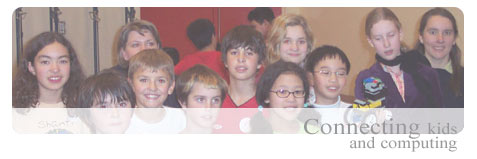
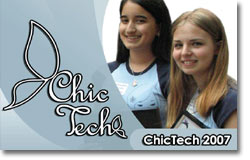
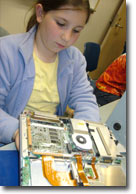 The
building is futuristic, made of unfinished cement and glass.
Its corridors are dark and its floors are accessible only
by key card. If you listen closely, though, you can hear the
unmistakable sound of giggling. It seems like an unusual place
for dozens of Grade 6 and 7 girls to be spending their Saturday
afternoon, but by the sounds of it, they’d disagree.
The
building is futuristic, made of unfinished cement and glass.
Its corridors are dark and its floors are accessible only
by key card. If you listen closely, though, you can hear the
unmistakable sound of giggling. It seems like an unusual place
for dozens of Grade 6 and 7 girls to be spending their Saturday
afternoon, but by the sounds of it, they’d disagree.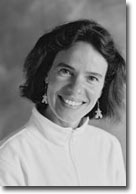 “Did
I mention that I became a mathematician by accident?” said
Dr. Rebecca Tyson, a tenure track professor at UBC Okanagan. It
was that comment of hers that immediately put me at ease given that
I’m about to enter my last year of undergraduate studies in
science at UBC, and still without a concrete goal. It was comforting
to hear a successful researcher (someone on the other side of the
dark tunnel of mystery) admit that it took a little exploration
to navigate into the career she loves.
“Did
I mention that I became a mathematician by accident?” said
Dr. Rebecca Tyson, a tenure track professor at UBC Okanagan. It
was that comment of hers that immediately put me at ease given that
I’m about to enter my last year of undergraduate studies in
science at UBC, and still without a concrete goal. It was comforting
to hear a successful researcher (someone on the other side of the
dark tunnel of mystery) admit that it took a little exploration
to navigate into the career she loves.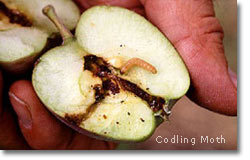 Rebecca
Tyson is a dynamic woman. About a month ago, I interviewed her about
her involvement with A Career In Science: Workshop for Female Undergraduates,
a workshop she led at the University of British Columbia Okanagan,
where she is a tenure track professor and researcher in mathematical
biology. In the process, I became fascinated by her research and
the exciting prospect of using mathematical biology to solve real
world problems. As a result, I wanted to know more.
Rebecca
Tyson is a dynamic woman. About a month ago, I interviewed her about
her involvement with A Career In Science: Workshop for Female Undergraduates,
a workshop she led at the University of British Columbia Okanagan,
where she is a tenure track professor and researcher in mathematical
biology. In the process, I became fascinated by her research and
the exciting prospect of using mathematical biology to solve real
world problems. As a result, I wanted to know more.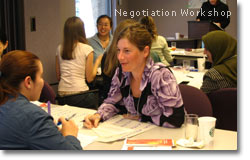 “Most
women are under the mistaken impression that if they do good work
at their job, they’ll automatically be rewarded with a salary
increase”, says Julie Stitt who facilitated a JADE-funded
negotiation workshop for women. “The consequence is that women
don’t ask for what they deserve”, explains Stitt. During
her thirteen years in career development and human resources development,
Stitt has observed that many women don’t do the background
research to find out what their work is worth, and what compensation
they actually need to make them happy in their employment.
“Most
women are under the mistaken impression that if they do good work
at their job, they’ll automatically be rewarded with a salary
increase”, says Julie Stitt who facilitated a JADE-funded
negotiation workshop for women. “The consequence is that women
don’t ask for what they deserve”, explains Stitt. During
her thirteen years in career development and human resources development,
Stitt has observed that many women don’t do the background
research to find out what their work is worth, and what compensation
they actually need to make them happy in their employment.